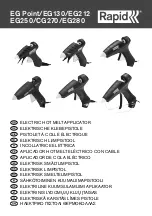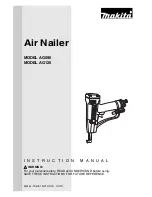
Page 15
For technical questions, please call 1-888-866-5797.
Item 57180
S
AFE
ty
Op
ERA
ti
O
n
M
A
int
E
n
A
nc
E
S
E
t
U
p
troubleshooting
problem
possible causes
Likely Solutions
Insufficient
fastener depth.
1. Incorrect tool depth setting.
2. Incorrect lubrication or not
enough lubrication.
1. Adjust depth setting, if available.
2. Check for loose connections and make
Fasteners drive
too deeply.
Incorrect Tool depth setting.
Adjust depth setting, if available.
Tool cycles without
driving fastener.
1. Jammed fastener.
2. Tool empty.
3. Incorrect fasteners used.
4. Magazine dirty or not
lubricated properly.
1. Clear jammed fastener according to
Clearing Jams instructions.
2. Reload with correct fasteners.
3. Empty, then reload with correct fasteners.
4. Clean and lubricate Magazine and Pusher.
Frequent jamming.
Incorrect nail type.
Confirm nail collation type, diameter, angle,
type, and length. Correct as needed.
Tool will not start.
1. Battery Pack not properly
connected.
2. Battery Pack not properly
charged.
3. Battery Pack burnt-out.
4. Internal damage or wear.
(Carbon brushes or
Trigger, for example.)
1. Remove Battery Pack, make sure there are no
obstructions, reinsert the Battery Pack according
to its shape (it should only fit one way), and press
firmly until the Battery Pack locks in place.
2. Make sure Charger is connected and
operating properly. Give enough time for
Battery Pack to recharge properly.
3. Dispose of old Battery Pack
properly or recycle. Replace Battery Pack.
4. Have technician service tool.
Tool operates slowly. 1. Forcing tool to work too fast.
2. Battery Pack wearing out.
1. Allow tool to work at its own rate.
2. Dispose of old Battery Pack
properly or recycle. Replace Battery Pack.
Performance
decreases over time.
Carbon brushes worn or damaged.
Have qualified technician replace brushes.
Excessive noise
or rattling.
Internal damage or wear. (Carbon
brushes or bearings, for example.)
Have technician service tool.
Overheating.
1. Forcing tool to work too fast.
2. Blocked motor housing vents.
1. Allow tool to work at its own rate.
2. Wear ANSI-approved safety goggles and
NIOSH-approved dust mask/respirator while
blowing dust out of motor using compressed air.
Follow all safety precautions whenever diagnosing or servicing the tool.
Disconnect Battery pack and charger power supply before service.






































